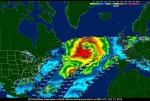
Tuesday, November 29th, 2016
On Sept. 21, 2014, NASA scientists and engineers launched RapidScat toward the orbiting International Space Station, 250 miles above Earth’s surface, with a few objectives in mind: improve weather forecasting on Earth, provide cross-calibration for all international satellites that monitor ocean winds, and improve estimates of how ocean winds change throughout the day. Following the
Monday, October 10th, 2016
WESTMINSTER, Colo. – DigitalGlobe, Inc. (NYSE: DGI), the global leader in earth imagery and information about our changing planet, today announced the WorldView-4 satellite launch has been delayed due to ongoing efforts to restore and test infrastructure at Vandenberg Air Force Base following last month’s wildfires. DigitalGlobe is working closely with the U.S. Air Force
Friday, September 16th, 2016
As announced at World Satellite Business Week by Nicolas Chamussy, Head of the Business Line Space Systems within Airbus Defence and Space and confirmed by Bernhard Brenner, Head of Intelligence Business Cluster at Airbus Defence and Space, Airbus Defence and Space is designing and building a new constellation of optical satellites, comprising four identical and

Tuesday, August 9th, 2016
The pioneering Aladin sensor, a spaceborne LiDAR instrument with two powerful lasers, a large telescope and very sensitive receivers, is ready to join its Aeolus satellite for launch in 2017. Designed by Airbus Defence and Space, Aladin’s laser generates ultraviolet light beamed toward Earth, which bounces off air molecules and small particles such as dust,
Thursday, August 4th, 2016
ENGLEWOOD, COLO. — Surrey Satellite Technology (Surrey) announces the expansion of its low-Earth orbit (LEO) satellite platform product capability with an extended nanosatellite offering. This follows the recent announcement by Surrey of its contract award for the VESTA nanosatellite mission. Surrey’s expanded LEO product capability now includes additional configurations suited for missions ranging in mass
Tuesday, July 12th, 2016
12 July 2016 — In the most detailed picture to date, information from ESA’s CryoSat satellite reveals how melting ice in Greenland has recently contributed twice as much to sea-level rise as the prior two decades.Between 2011 and 2014, Greenland lost around one trillion tonnes of ice. This corresponds to a 0.75 mm contribution to
Thursday, July 7th, 2016
Paris, Washington D.C., Montreal, Yokohama, July 7, 2016 – According to Euroconsult’s latest report, Prospects for the Small Satellite Market, we are on the cusp of a major revolution for the space sector and overall space ecosystem, as more than 3,600 smallsats are expected to be launched over the next ten years, a significant increase from
Thursday, June 23rd, 2016
WESTMINSTER, Colo.— DigitalGlobe, Inc. (NYSE: DGI), the global leader in earth imagery and information about our changing planet, today announced its WorldView-1 satellite has completed a planned 18-month-long transition from a morning orbit to an afternoon orbit, improving customers’ ability to detect, see, and understand change that occurs on our planet within a single day.
Tuesday, June 14th, 2016
Researchers from around Australia have begun testing satellites at the Mount Stromlo space testing facilities at The Australian National University (ANU) ahead of a mass satellite launch from the International Space Station later this year. Three CubeSats, satellites built from cubes about 10 centimetres per side, have been developed by researchers at ANU, the University